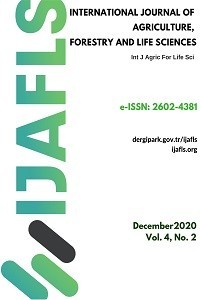Yield and physicochemical properties of lowland rice (Oryza sativa L. var. NSIC Rc218) as influenced by water and fertilizer applications
Yield and physicochemical properties of lowland rice (Oryza sativa L. var. NSIC Rc218) as influenced by water and fertilizer applications
AWD, flooded condition, growth factors grain yield, physicochemical properties,
___
- BELDER, P., B. A. M. BOUMAN, J. H. SPIERTZ and R. TUONG. 2004. Effect of water and nitrogen management on water use and yield of irrigated rice. Agricultural Water Management, 65:193-210.
- BELDER, P. 2005. Water saving in lowland rice production: An experimental and modeling study. PhD dissertation. Wageningen University Library. Retrieved on Nov. 9, 2014. Wur.nl/wda/dissertations/dis3779.pdf.
- BOUMAN, B. A. M., R. M. LAMPAYAN, and T. P. TUONG. 2007. Water management in irrigated rice: Coping with water scarcity. IRRI, Los Baños, Philippines. www.irri.org/irrc/publications/water%20management_1.pdf. February 16, 2010.
- CANTRELL, H. L. 2004. Irrigation of water scarcity. Gadja Madja University, 33 pp.
- FAYLON, P. S. and E. C. CARDONA. 2007. Philippine Agriculture: Retrospect and Prospects in Good Agricultural Practices Amid Globalization. Los Baños, Laguna, Philippines: Philippine Council for Agriculture, Forestry and Natural Resources Research and Development (PCARRD).
- MACLEAN J. L., D. DAWE, B. HARD and G. P. HETTEL. 2002. Rice Almanac. IRRI, Los Baños, Philippines. 253 pp. Retrieved March 24, 2010 from www.books.google.com.ph/books?isbn-0851996361.
- RATILLA, M. D. and U. A. CAGASAN. 2011. Growth and Yield Performance of Selected Lowland Rice Varieties under Alternate Wet and Dry Water Management. Annals of Tropical Research, 28 (23): 2-14.
- STOOP. W. A., N. UPHOFF and A. KASSAM. 2002. A review of agricultural research issues raised by the system of rice intensification (SRI) in Madagascar: opportunities for improving farming systems for resource-labor farmers. Agricultural Systems. 71: 249-274.
- TUONG T. P. and B. A. M. BOUMAN 2002. Rice cultivation and water scarcity. Grammen Bank, Bangladesh. p. 12.
- Yayın Aralığı: Yılda 2 Sayı
- Başlangıç: 2017
- Yayıncı: Volkan OKATAN
Organic fig (Ficus carica l.) growing: determination of pesticide residues
Malvaceae spp. leaves as a novel crop for food
Eyal BEN-SİMCHON, Eliezer SAPİR, Yiftach VAKNİN, Oren SHELEF
Lorena ZUDAİRE, İnmaculada VİÑAS, Tomas LAFARGA, Lucia PLAZA, Gemma ECHEVARRİA, Gloria BOBO, Rosa ALTİSENT, İngrid AGUİLÓ-AGUAYO
The effect of particle sizes on ammonium adsorption kinetics and desorption by natural zeolites
Veli UYGUR, Canan ŞANLI ÇELİK, Enise SUKUSU
Effect of variety and planting dates on mungbean green pod and dry seed yields
Ezzat ABD EL LATEEF, Ahmed EATA, Mostafa ABD EL-SALAM
Polyphenol content and antioxidant capacity of berries: A review
Muhammet Ali GÜNDEŞLİ, Nazan KORKMAZ, Volkan OKATAN
Effects of fig seed flour on some quality parameters of cookies
